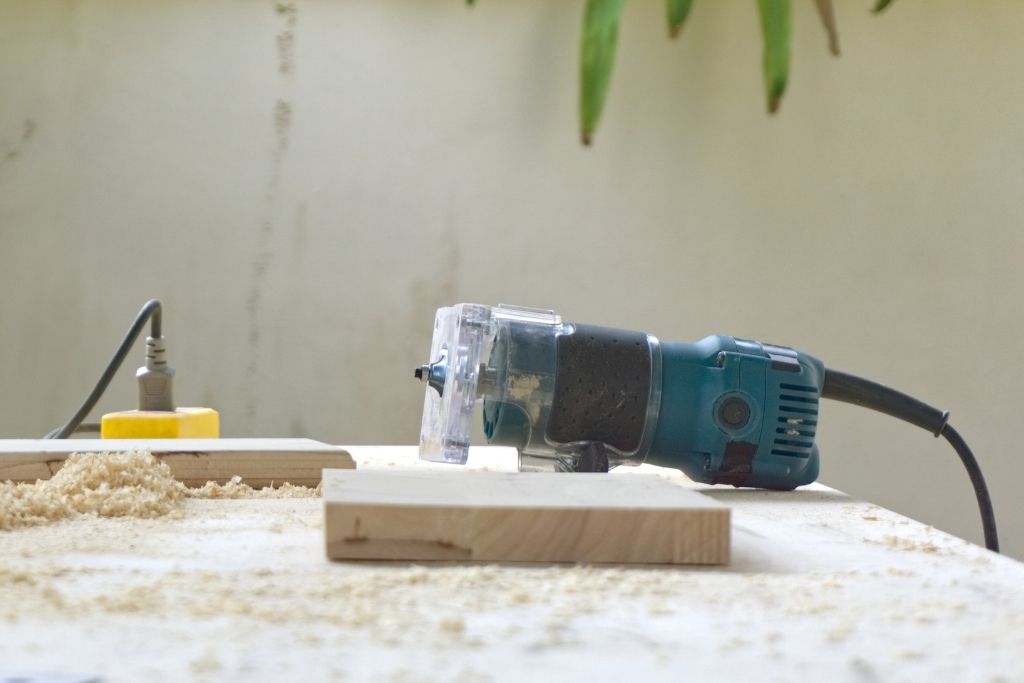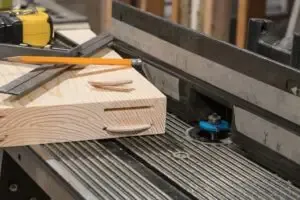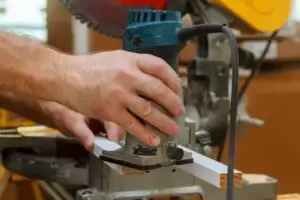
Compact routers have smaller and lighter than other router tools in woodworking.
They fill the gap between typical trimming routers and full-sized models. And in certain carpentry projects, compact routers are a must.
The small size is a blessing but can also be confusing. Many may not know when exactly they need a tool like this. Or how to make a choice when so many models look similar.
This guide will help you find the best compact router. Check it to add another awesome tool to your workshop.
Table of Contents
- Top Rated Compact Routers Comparison
- Different Types Of Compact Routers
- 5 Best Compact Routers – Reviews
- How To Choose The Best Compact Router
- Tips When Using A Compact Router
- Frequently Asked Questions About Compact Router
- When Should I Get A Compact Router?
- What Are The Disadvantages Of Compact Routers Compared To Full-sized Models?
- Should I Have Bigger Routers In Addition To A Compact One?
- Are Compact Routers And Laminate Trimmers The Same?
- What Extra Accessories Should A Compact Router Come With?
- Can You Use a Compact Router in a Router Table?
- Can I Make Picture Frames with a Compact Router?
- Conclusion
Top Rated Compact Routers Comparison
Different Types Of Compact Routers
Compact routers break down into categories based on their base designs, just like their regular-sized cousins.

Fixed-Base
In these routers, the position of the router bit doesn’t change during the cut. If you preset the cut depth at 3/8″, the router bit will always protrude past the base 3/8″ until you turn it off and adjust the depth again.
Remember that “fixed-base” compact routers are still adjustable after cutting. You can change the depth by twisting a dial or loosening a collar.
There are also tilting bases. They are fixed bases that tilt at a certain angle. These bases are for working inside corners and at odd angles.
Plunge
Plunge routers have a spring-loaded motor housing that can travel up and down.
This mechanism allows the operator to change the depth of the cut on the fly. You can just turn the router on and push a spinning router bit into the material with no issue.
With this type of base, your dados and mortises will be a lot cleaner. Varying the cutting depth across the workpiece should be easy too.
Each plunge router has its own range of depths. You can lower or raise the housing between these limits by using a knob or lever. Manufacturers usually use a depth gauge to prevent the router bit from plunging too deep.
These instant vertical movements make plunge routers a great tool for several detailed cuts. They include patterns, through cuts, mortises, deep grooves, and template work.
Combo
Many compact router kits come with interchangeable parts with both fixed and plunge bases. These combination kits allow you to swap one base for another.
They are usually more expensive. And changing out bases while cutting can slow down your workflow. But you can enjoy the best of both worlds without having to own two separate routers.
5 Best Compact Routers – Reviews
1. Makita RT0701CX7 Compact Router

If you are going after a long-term investment for light trimming or profiling work, get this Makita compact router.
The tool uses a 1.25HP motor – among the most powerful choices you can have. But Makita still manages to keep the router fairly compact and lightweight at 3.9 pounds. You should have no trouble operating it with only one hand.
The dial on the top allows you to set the speed between 10,000 and 30,000 RPM. Depth adjustment is straightforward with the rack-and-pinion-style knob. There are three preset depths, but fine adjustments are possible too.
A lot of compact routers tend to jump when starting up. This is not the case with this Makita model. The slow start feature means a gentle and controllable start-up.
Makita uses rugged aluminum to make the double-insulated housing. The result is a durable body that can last for a very long time.
Keep in mind that the full kit with three bases is not a cheap purchase. The standalone router is much cheaper. But it doesn’t come with many accessories.
- High power and great variable speed controls
- Ready to use with many accessories.
- The fixed base is compatible with many template guides.
- Smooth startups and safety with soft start mechanism
- The body is highly maneuverable with one hand.
- Easy depth adjustments
- The full kit is quite expensive.
- There is no light guiding.
- Not include bit, need buy separately
2. Bosch Colt PR20EVS Compact Router
Get this router if you are new and want to get a firm grasp of these compact tools. Several ergonomic features make the Bosch Colt a great tool even for beginners.
The housing has a palm-grip design to provide the most comfortable control. The fixed base comes with two support pockets. They help newcomers gain better stability while trimming.
The Bosch Colt is a corded router. But the ball-joint swivel makes it easier to position the power cord and prevent tangling. Both macro and micro depth adjustments work well with two separate knobs.
The 1-HP motor is slightly weaker than top-of-the-line models. But it is still decent for a wide array of woodworking tasks.
This router can have some heat build-up after a long period. You may not need to use gloves, but it is still a little uncomfortable.
- Ergonomic palm-grip design.
- Highest top speed among these choices.
- Easy bit change fast
- Many additional bases and accessories are available.
- Easy to adjust or move the motor with the quick-clamp system.
- Height adjustments don’t work well all the time
- More vibration when top speed
3. DeWalt DWP611PK Fixed/Plunge Base Kit
The biggest highlight of this tool is how it allows you to keep track of your workpiece. DeWalt equips it with a clear plastic fixed base and two bright LED lights. They provide the super visibility that metal bases can’t rival.
Visibility is critical to detail work. We have seen people wearing a headlamp and attaching mini desk lamps to their router. Imagine doing some kerfing to bend your workpiece but cannot see where your bit is going.
Other aspects of this tool are great too. It uses a 1.25HP motor under the hood. There are air vents around directing airflow to keep it as cool as possible. The router doesn’t run as hot as models of the same power rating.
The main body is a combination of signature yellow DeWalt plastic and aluminum. The item provides a comfortable grip and feels stable while cutting.
The compact size makes it very easy to control the DeWalt DWP611PK. One hand should be enough for you to palm and guide it, creating even and smooth edges.
The soft-start plays a huge role here too. Once turned on, the motor ramps up slowly towards the pre-defined speed. It is much better to have this compared to experiencing a jerky startup with instant-on motors.
The biggest downside of the DeWalt DWP611PK is its limited speed range. It can be underwhelming when using small rubber bits.
- LED lights and transparent bases for easy visibility while operating
- Spring-loaded release tabs for quick base removal.
- A stable speed with the full-time electronic feedback
- Grip with the rubberized handles
- Great micro-adjustments with 1/64-inch increments with fixed base
- Easy to change router bit changes with shaft-lock detents.
- Impressive depth capability with the plunge base (2 inches).
- There is no hardshell case.
- Hard to see and feel the on-off switch.
- You will have to purchase dust collection adapters separately
4. Milwaukee M18 Fuel Cordless Compact Router
The Milwaukee M18 Fuel is in its own class when it comes to cordless compact routers. The small body can still hold a 1.25HP motor besides the battery pack. It is the lightest choice with this level of power output.
It is a bit more top-heavy than corded routers, but is very easy to handle as a cordless one. When holding the tool sideway to work on the inside of a cabinet, we find it to be more balanced than many other cordless routers.
Thanks to that powerful battery pack, the Milwaukee M18 Fuel can handle any task a similar corded model can. This includes, among other things, edge profiling, flush trimming, and hinge mortising.
The default package comes with no plunge bases. However, there is an extra-large additional baseplate.
It provides more support on large workpieces, while the default, smaller base excels in thin edges. The balance of this router on narrow edges is very impressive without any wobble.
There is an edge guide and dust collection port in the box too. It is easy to attach or take off this port to prevent sawdust.
The Milwaukee M18 Fuel uses a button for macro and a dial for fine-tuning depth settings. They are easy to access and quick to adjust.
A side button for big allows for big jumps, while the screw can make precise settings as small as 1/64 inches. After adjustments, the base and bit stay firmly in place.
Be aware that the default package doesn’t include the package pack. You have to find the right pack, and this could be a whole ordeal for many people.
- Excellent access to hard-to-reach areas.
- The power and speed are comparable to corded models.
- Fast and easy-to-use depth adjustments.
- Includes variable speed control
- The built-in Intelligence circuit protects the router from overheating
- You will have to purchase the plunge base and battery separately.
- The top is heavy with the battery pack inside.
5. CtopoGo Compact Wood Router
This router is the perfect choice when you just need a simple and inexpensive tool for some simple work.
CtopoGo offers an impressive number of accessories in the box. You will have a 12-piece bit set, a trimming guide, a straight guide, a guide plate, and two wrenches. It’ll be hard to find any other offer that can beat this pricing.
Being a fixed-base router, the tool requires extra precision from your hand to make joinery. The included grooving bit and dovetail bit surely help. To make save your pinky toe from the painful corners, there is a chamfer bits as well.
Most of the main body is made of plastic, but there are also aluminum parts. These material choices make the CtopoGo router very lightweight and easy to maneuver. The non-slip handle is a great help with this too.
The biggest surprise is how silent this tool is while routing. In most cases, hearing protection isn’t necessary.
The clear plastic bottom is a big deal if you prefer to have a broader view of your cuts. You can’t change the speed, but the maximum 30,000 RPM is still decent for a compact router.
Just make sure you don’t use this tool for deep cuts or big projects. The collet may also let go of the router bit sometimes too, which is quite dangerous.
Another big let-down is the manual. It doesn’t have many clear instructions showing how to use the router. Beginners may need quite some time to figure out everything about this tool.
- The whole package offers great value for money.
- It is easy for beginners to learn and use.
- The clear base improves visibility.
- The tool is quiet in operation.
- It is strong enough for many trimming and profiling works.
- The instructions aren’t clear.
- There is no way to adjust speed.
- Can’t use it for heavy-duty tasks.
How To Choose The Best Compact Router
Most compact routers look and work the same way. But many considerations determine whether they are suitable for your needs.

Type Of Base
- Fixed Base
Fixed-base compact routers are the more stable and beginner-friendly tool.
It is easy to set up and operate them with your hand closer to the workpiece. This design demands less skill and experience from the operator. And the price is usually also lower than that of a plunge model.
If most of your work involves making identical cuts or edge shaping, they are an ideal choice. Just lock the router bit into place and use the same setting over and over again.
A fixed base also allows you to fine-tune the depth of the router bit to a high degree. If you are about to cut a dovetail joint with a dovetail jig, a fixed-base router is more reliable.
The downside is you will not get clear starting and stopping points at the center of a board with these routers. These points are essential for dados and mortises.
- Plunge Base
You have more freedom with plunge base ones. They are a great tool if you want to make complex cuts like tenon joinery. It is also easier to carve inside the material (like mortises) with them.
Bear in mind that plunge models tend to cost more. Additionally, you will need some practice to adjust the tool on the go. But in return, you have more control over the cut’s depth and appearance.
Power Rating
Manufacturers usually don’t tell us the amount of torque their routers can actually provide. You will need to look at the power rating to know how powerful they can be.
Most compact models can deliver no more than 1.25 horsepower (HP). A bigger figure allows you to handle denser materials and larger router bits. It speeds up heavy-duty tasks as you don’t need to perform multiple passes anymore.
But a powerful one can be too bulky for light woodworking jobs. A smaller model would offer finer control and could still get the job done
Weight
Opt for lightweight ones when maneuverability is your concern. It is harder to push a bulky tool along the workpiece. A bigger weight can also make your hands tired more quickly.
It will be fine with weight around 3 to 6 pounds for a compact router.
Power Source Type
Compact routers can run on either batteries or regular power cords.
Cordless models save a lot of hassles. You can maneuver your router more freely and work where no power sources are available.
But you will have to recharge them regularly. And there is a limit on the runtime of battery-powered models.
You will have less portability with corded models. The power cord is also prone to tangling. But there is no charging involved, and they can work during long sessions.
Also, the corded models are more powerful than cordless.

Depth Range
This limits how deep you can cut into the material. The maximum depth travels of the plunge and fixed bases are different on 2-in-1 models. Make sure they are compatible with your projects.
Ergonomic Design
The handle should offer a good grip. This usually comes from well-designed contours and non-slip coatings like foam, PU, or rubber.
They make sure you have greater control over your tool all the time.
Otherwise, it can slip off your hands due to heavy vibrations. Unsafe handling like that can cause serious accidents while routing.
It is better if you can test this first-hand. You should be able to feel a solid hold and a comfortable fit. This step is very important if you are a beginner or have small hands.
The controls should be located near your hands as well for more convenience.
Durability
The housing should be nearly all-metal. It does not just help your router last longer but also provides more stability.
Rugged aluminum is a common choice for this purpose. It guarantees excellent durability without giving up much lightness.
Adjustable Bit Height
Most models offer some ways to adjust the bit height. Common mechanisms are sliding docks and rack and pinion gears.
You should check the minimum increments allowed to. Smaller length means you will have finer control over the cut depth. This superior depth control is crucial in many detailed woodworking projects.

Spindle Lock
The spindle lock helps you easier change bit and quick without any effort. This feature is convenient so you don’t need to remove the motor to access bits. Special, it is necessary for plunge routers.
Add Features
You will have a more pleasant time if your tool comes with some of these additional features.
- Variable Speed Control
Different router bits and applications call for a different ideal speed range. A router going too fast can burn the wood when you create edge profiles, for instance.
Some models have variable speed control to help you with this. The mechanism often comes in a small dial. You can tweak it to set the proper speed for your next task.
- Electronic Motor Feedback
This electronic control means the router can maintain a stable speed while cutting. The built-in sensors can detect whether the router bits are spinning too fast or slow.
They keep the tool running at your prescribed speed even if the wood’s density changes.
- Soft Start
A soft start means the router doesn’t speed up suddenly. Instead, the motor has a more gentle acceleration towards the preset speed. This small feature makes the tool less likely to jerk out of your hands.
- Fast Stop
A built-in electric brake can bring the router bit to a halt almost immediately. You won’t need to wait for a few seconds for it to wind down entirely before putting it down.
- LED Lights
Some built-in lighting can make a night-and-day difference. When your workshop is dimly lit, or its lighting system can’t reach the cut, some bright LEDs will help you see and monitor the cut. A built-in lighting system is extra beneficial with non-transparent bases.
- Dust Collection
A built-in dust collection port can reduce the amount of sawdust on and around your workpiece. It can’t only make cleanups easier but also allow you to see the cut more clearly.
Accessories
It is important to know what the manufacturer provides in the bag besides the main product.
A great number of included cutting bits means you don’t have to buy them later. Other accessories can be helpful too.
A solid bag will help you store and carry your tool easier, wrenches to quick assemble, while a guide helps make precise cuts, etc..
But a full-fledged package usually carries a higher price tag. You can start with the essentials, then buy the extras you need later.
Tips When Using A Compact Router

These practices can save you from some common errors and even accidents:
Make shallow cuts first: Most (if not all) compact models use only a 1/4″ shank. Making a deep cut right away can break the router bit.
Attach the router bit properly: Make sure the collet keeps the router bit securely in place. However, prevent the bit from bottoming out the collet.
Select the proper speed: Most compact routers provide a wide range of bit speeds. Choosing this correctly for each cut is crucial.
The routering bit spinning too quickly will burn the wood. But a too slow speed can result in a ragged cut. This speed depends on the material as well as the size and type of the bit. The rule is the smaller the bit, the higher the speed.
Pay extra attention to large-profile router bits: Avoid holding the device with only one hand. Keep your hands away from the baseplate as much as possible.
When burned edges happen: Set a slower speed and move the tool more slowly.
When adjusting depth: Wait for the router bit to stop completely before changing your setting.
Use a tilt base to trim odd angles: This is a common accessory for many models, such as the Bosch Bolt. It removes the need for a special jig.
Trimming narrow stocks: Use a support board that is as thick as your workpiece. It gives your router a wider support base for moving.
Frequently Asked Questions About Compact Router

When Should I Get A Compact Router?
Compact routers can handle a great set of light-duty tasks like:
- Chamfers,
- Round-overs,
- Shallow rabbets and dadoes,
- Edge trimming and profiling.
They are a great choice for beginners to learn routing too. Compact routers cost less than full-sized models. You can have some money left to buy additional attachments.
What Are The Disadvantages Of Compact Routers Compared To Full-sized Models?
The limited size can mean the motor may not be powerful enough for heavy-duty tasks. You will lack the muscle to build big projects like a bed.
Compact models mostly use a 1/4″ collet, so your 1/2″ shank router bits are out of the question. The 1/2-inch size is generally better. It is stronger, offers better stability, and dissipates less heat into the wood.
Sometimes there is only one handle, and you have to keep the other hand on the baseplate. This can be dangerous with big spinning router bits.
Should I Have Bigger Routers In Addition To A Compact One?
It is a great idea to have both a compact and a full-sized router in your workshop. You will have an ideal tool for every routing task and perform larger projects.
Are Compact Routers And Laminate Trimmers The Same?
Not exactly. Laminate trimmers are small wood routers designed for trimming laminate or plastic. They and compact routers have many things in common. You can even use a laminate trimmer for some light wood profiling work.
But laminate trimmers are often less powerful and have only a plastic fixed base. You should not use them as a one-to-one replacement for a compact router.
What Extra Accessories Should A Compact Router Come With?
Pay attention to the number of router bits and swappable bases in the box. They decide which cuts you can make with your tool. Guides, dust collection adapters, and wrenches are great to have too.
Can You Use a Compact Router in a Router Table?
Yes, if they are compatible. Check the requirements of the router table, such as hole patterns and base plate diameter.
Can I Make Picture Frames with a Compact Router?
You can use it and router bits like slot-cutting and roman ogee bits to make picture frames.
Conclusion
All things considered, the Makita RT0700CX3 is the go-to choice if you need a great all-around compact router.
It ticks all the boxes. The motor is the most powerful in this range. The speed range is great, while fine depth adjustment is precise and easy to use. Every control is easy to access, and the durable construction can stand up to the constant operation.
If you are a Dewalt loyalist, the DWP611PK will make you happy. Everyone loves its LED lights. Its other aspects, like the plunge base and the motor, uphold the reputation of the brand too.
Overall, compact routers are a nice addition to your workshop. It makes many detailed routing applications like edge profiling more pleasant to do.
Most of them use only 1/4″ shank router bits, and the power rating rarely goes beyond 1.25HP. But compact routers are still a versatile tool for many woodworkers.







![How To Start A Woodworking Business [Ultimate Guide] How To Start A Woodworking Business [Ultimate Guide]](https://handykeen.b-cdn.net/wp-content/uploads/2021/10/woodworking-business-1-300x200.jpg)


![9 Best Pole Saws of 2023 [Ultimate Guide] 9 Best Pole Saws of 2023 [Ultimate Guide]](https://handykeen.b-cdn.net/wp-content/uploads/2021/03/best-pole-saw-300x200.jpg)
